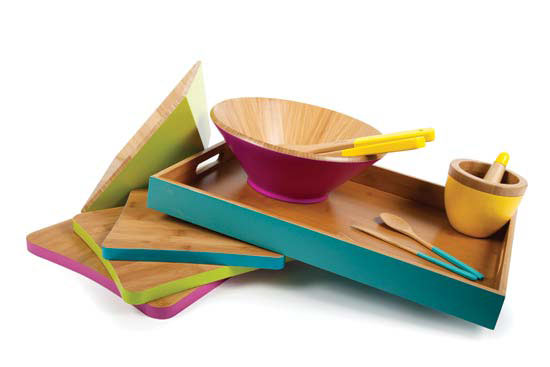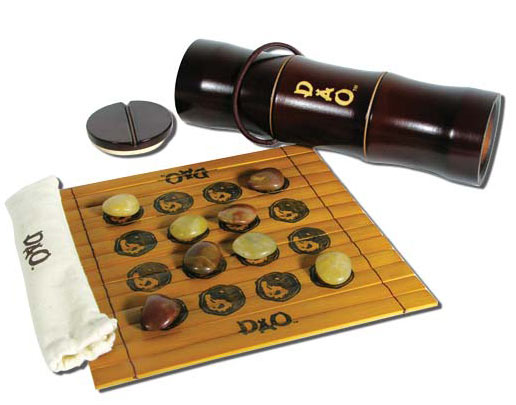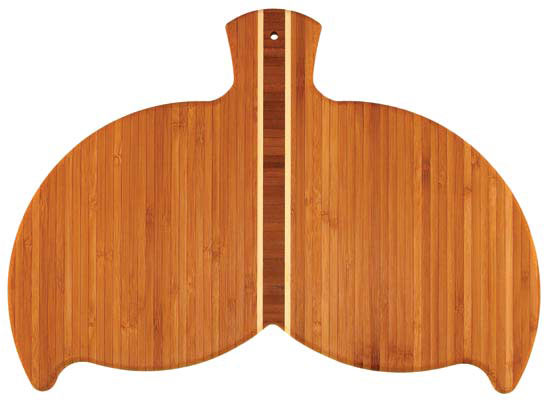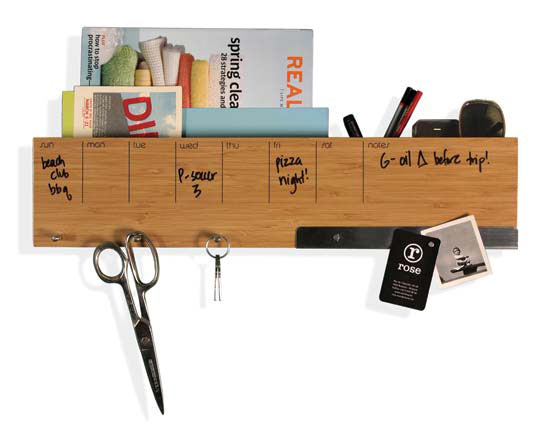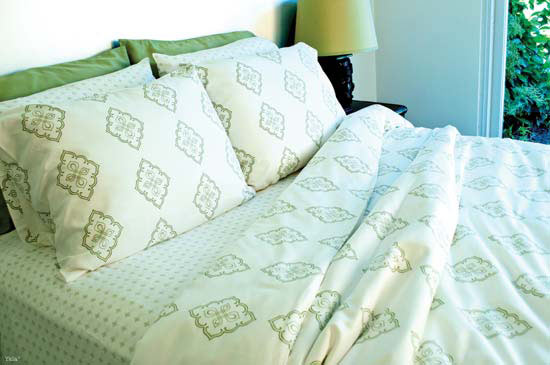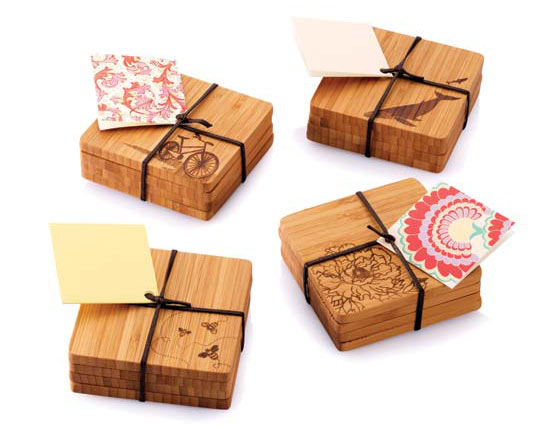Boom Time for Bamboo
This grass is truly green. Bamboo’s biggest asset, its sustainability, has made it a darling in the green industry and wholesalers are morphing it into a variety of fun products.
When Tom Sullivan first saw bamboo flooring, he loved it. He also saw the potential of bamboo beyond flooring, and developed a bamboo cutting board, which he took to a street festival.
“My wife and I were just a couple of artists from California, trying something new,” Sullivan says, “but we were floored by the attraction those cutting boards received.”
Sullivan’s street fair booths eventually grew into his San Marcos, CA-based company, Totally Bamboo. The original cutting boards have given way to 160 products, ranging from kitchen utensils to picture frames. He still makes cutting boards, although today they come in a variety of shapes and designs. “Cutting boards shaped like wine glasses are popular,” Sullivan says, “and we have a new board that looks like a log from a tree. It is oval with rings laser-cut into them. The rings are actually tiny animals from all around the world.”
Originally, according to Sullivan, his customers were young and eco-friendly – people who were interested in environmentally friendly products before “green” became a mainstream movement. Now, his customers are interested in his products because of the all-round positive characteristics of bamboo. It isn’t just green; bamboo is functional and attractive. “Kitchen gurus love it,” Sullivan says.
From fringe to mainstream
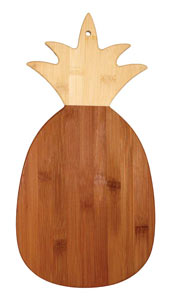 “Bamboo has really gone mainstream,” says Steve King, a partner and designer with Bamboo Designworks in the San Francisco Bay area. “Not too many years ago, we had to explain bamboo’s many positive attributes. Now, most everyone seems familiar with the benefits of bamboo.”
“Bamboo has really gone mainstream,” says Steve King, a partner and designer with Bamboo Designworks in the San Francisco Bay area. “Not too many years ago, we had to explain bamboo’s many positive attributes. Now, most everyone seems familiar with the benefits of bamboo.”
King’s company is best known for its bamboo jewelry and bookmarks. “Customers like our products because they are attractive and affordable, but also because they are green,” he says. “Some people are specifically looking for green product alternatives to conventional products.”
When it comes to bamboo, these “green product alternatives” are seemingly endless. Interior designer Blanche Garcia especially appreciates the look of a bamboo floor, but she also utilizes bamboo furniture, light fixtures, and even wallpaper. “Everybody wants to use it,” she says, “because it is so attainable.”
Sustainability sells
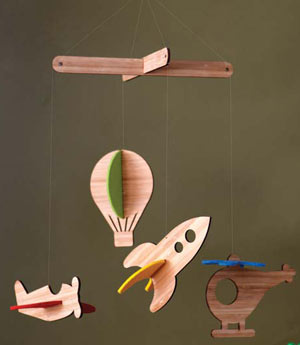 Yes, it is the green aspect of bamboo that appears to be at the heart of its popularity. As strong as any wood product, bamboo is actually a grass. And as a grass, it regenerates quickly, growing as much as two feet in a 24-hour period. Bamboo grows up to 90 feet tall and can be harvested in three to five years – the longer it stands uncut, the stronger and more durable it becomes. Compare that to the fifty or more years a hardwood tree takes to reach full growth, and it is easy to see why bamboo has become such a popular sustainable material.
Yes, it is the green aspect of bamboo that appears to be at the heart of its popularity. As strong as any wood product, bamboo is actually a grass. And as a grass, it regenerates quickly, growing as much as two feet in a 24-hour period. Bamboo grows up to 90 feet tall and can be harvested in three to five years – the longer it stands uncut, the stronger and more durable it becomes. Compare that to the fifty or more years a hardwood tree takes to reach full growth, and it is easy to see why bamboo has become such a popular sustainable material.
According to Sullivan, experienced harvesters scratch dates on the bamboo so they know which stalks are ready and which are to be left behind. The mother root of each stalk is cut, and this allows for two new growths – another aspect of the plant’s regeneration that makes it an ideal green material.
“The best part of the harvesting method is the hand-selection and hand-cutting of the bamboo,” explains Patrick Carland, Senior Vice President and General Manager at Bamboo Bottle Company of Truckee, CA. “This allows maturing and flowering strands to remain flourishing and minimizes the impact on ground soil since no heavy machinery is used.”
Carland sees bamboo as a sustainably harvested product that is a good alternative to plastic and metals, and that’s what makes it attractive to consumers. For example, one of the least sustainable products made is the plastic bottle used for soft drinks and water. As consumers turn to a more sustainable alternative– reusable bottles– the Bamboo Bottle Company took it one step further. “We use bamboo as a protective sleeve for our glass bottles,” says Carland. “We want to be good stewards of the earth and that’s one reason why we chose bamboo.” It is also sleek and durable, stylish and sensible, which is exactly what consumers are looking for in green products.
Bamboo primarily grows in Asia, mostly in China. For that reason, Jeff Delkin with bambu decided to set up his business there. “I see bamboo used everywhere and learned about its uses through the locals,” Delkin explains.
His company makes cutting boards and other kitchen items, using certified organic bamboo. “Since we are here in China, we were able to initiate a certification process for our sources of bamboo,” Delkin explains. “It ensures that our bamboo is grown without pesticides and chemicals. It’s an annual certification done by a group called IMO. We determined early on that this is going to be something we promote and our customers responded to. It’s an extra bit of insurance.”
 Delkin works with crafts people—”there’s a lot of handiwork in our products,” he says—before he ships it stateside. Shipping bamboo from Asia creates one very large carbon footprint, and it is the primary negative to bamboo’s green properties.
Delkin works with crafts people—”there’s a lot of handiwork in our products,” he says—before he ships it stateside. Shipping bamboo from Asia creates one very large carbon footprint, and it is the primary negative to bamboo’s green properties.
Bambu also offers a disposable bamboo product that is compostable, adding yet one more of bamboo’s green characteristics. “Turning to bamboo products is one small way that people can make an eco-friendly statement,” Delkin says. “We call it the poster child of renewable materials.”
However, Delkin points out that while bamboo is good for so many things, it isn’t perfect. “Some people have had bad experiences with bamboo,” he says. He blames those bad experiences on manufacturers who want to use young bamboo rather than wait for the bamboo to mature.
Sullivan agrees that some manufactures are using the less-than-ideal new growth. “With the rise of bamboo’s popularity, there has been a log jam of companies trying to get bamboo. So rather than waiting, they are turning to new growth,” he says. Another problem was a recent cold snap in China that killed a lot of the bamboo crop, leading people to essentially take what they could get. However, Sullivan adds, “China’s been a good steward of its bamboo crop, and while the weather kept the crop down, it isn’t out.”
Bamboo for babies
 Perhaps not unsurprisingly, bamboo has been found to be an ideal material for items geared toward children. As a wood, Lorena Siminovich, founder of San Francisco-based wholesaler Petit Collage, says bamboo is ideal for modern décor and playthings. “Our bamboo mobiles are one of our signature products,” she says.
Perhaps not unsurprisingly, bamboo has been found to be an ideal material for items geared toward children. As a wood, Lorena Siminovich, founder of San Francisco-based wholesaler Petit Collage, says bamboo is ideal for modern décor and playthings. “Our bamboo mobiles are one of our signature products,” she says.
The same bamboo used in the mobile hanging over a baby’s crib can also be used as the primary material for the baby’s sleeper and crib sheets. According to online retailer Green Earth Bamboo, demand for bamboo textiles has really increased over the past five years. Green Earth Bamboo’s Corey Dinerstein explains that “the bamboo is harvested and broken down into a viscose, which is used to make up the fabric.” Viscose is a form of wood cellulose used to make rayon. It is this rayon that creates the fabric, and because of that, there are many people in the bamboo industry who are skeptical that clothes or sheets or baby blankets can be truly called a bamboo product.
Nancy Morgan, founder of Yala Designs of Ashland, OR, disagrees with that assessment. She was first introduced to bamboo fiber during one of her frequent visits to China. “The bamboo is ground into a paper-like material and then is sent to the next process, which is spinning the paper like fiber with a solvent – sodium hydroxide – to create the viscose material,” she explains. And despite the solvent, the process used to create the fiber is green. “The processing is done in a closed loop system, which means that 98% of the chemicals and processing water is reused,” Morgan adds. “We viewed the holding ponds where the water is stored for reuse. We saw this entire process when we visited the production plant. The fiber is Oeko Tex certified, which means that there are no residue chemicals in the fiber.”
Yala Design became an early adopter of bamboo fabric, using it for nightwear and loungewear. It proved to be so popular that Morgan expanded into a full line of clothing for men, women, and children, and has recently added bed linens and bath sheets.
Lyn Pletscher has been selling Yala Designs in her Idaho City store, Lyn’s Linen Shop for years. “The loungewear is the most popular because people like how comfortable the fabric is,” she says.
Raija Keranen shop manager for Tottini, a Seattle store that sells nursery and baby furniture, toys, and clothing, also says bamboo products are a big seller. “People tend to lean towards bamboo because it’s so soft, as well as being naturally anti-microbial,” she says. The top sellers are bamboo washcloths and swaddling blankets.
One of the products that Keranen’s store sells is Satsuma Designs from Sequim, WA. The company focuses its products on the baby’s first year of life. “Our first collection was all in bamboo,” says owner Jennifer Porter. “We used a lot of jersey and velour.” Over time, Porter has added other bamboo-based fabric styles, such as terry cloth and flannel. “The flannel is 100% bamboo rayon.”
Among the most popular items are the baby scratch mittens, as well as the flannel washcloths and reusable wipes. Porter attributes the popularity of her baby items to the unusual softness of the bamboo rayon, no matter the type of fabric. She also thinks that bamboo’s qualities make for the ideal fabric for infants. “It feels like silk. It washes like cotton. It’s easy to care for, it’s absorbent, and it dries very quickly,” she says.
Overall, proponents of bamboo like that it is abundant, renewable, and affordable. “From our standpoint, we love bamboo’s properties and what it stands for as a sustainable product,” Porter says.
Mouse over images below to view.
